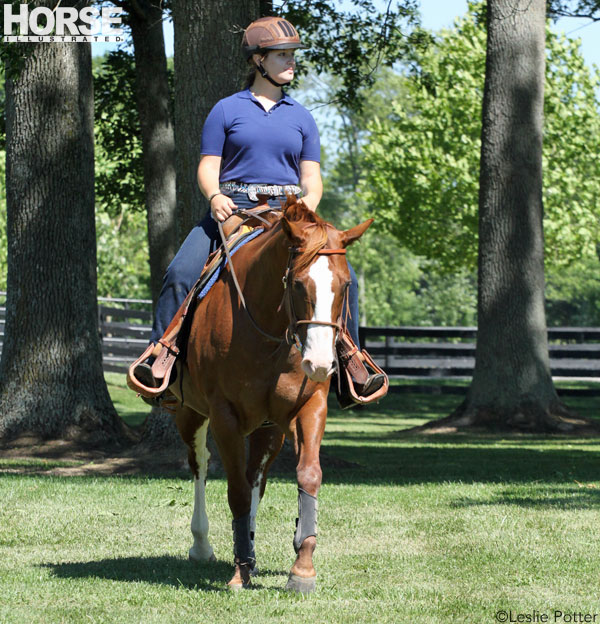The great thing about trail riding is that it’s truly a universal pleasure—all kinds of riders can enjoy it. It doesn’t demand a horse with a fancy pedigree, flashy tack or a special dress code, and you can take it at your own pace. A great trail horse can be any breed, and you can trail ride in any style of saddle. However, as trail riding has taken off in popularity, there are more saddle options being offered specifically for the trail rider, with features designed for fit and function over the long haul.

Fit is It
Whether you hit the trail in an English, western or hybrid model, like an endurance saddle, it must fit well. An ill-fitting saddle can cause sores and other physical damage to your horse. Pain from poor tack fit can also lead to behavioral problems ranging from general resistance to dangerous bucking or rearing. (See “7 Warning Signs” for indicators of poor saddle fit.)
Investment in a good saddle isn’t just for high-end performance and competition horses. As the miles on the trail add up, so do the problems caused by the wrong tack.
“Saddle fit is important for all horses, but particularly for the trail horse because they typically get ridden for a much longer period of time compared to a show hunter, jumper, or even a reining or roping horse,” says Joyce Harman, DVM, MRCVS, author of The Horse’s Pain-Free Back and Saddle Fit Book, The Western Horse’s Pain-Free Back and Saddle Fit Book, and two DVDs, Western Saddles and English Saddles (Trafalgar Square Books; www.horseandriderbooks.com).
You should check saddle fit on your horse regularly, too. As a young horse develops or your horse gets more fit during the riding season, his muscling and shape can change so that a saddle that once fit might not anymore. Older horses may also experience changes in their shape that can affect saddle fit.
“Pay attention to areas where you may see a few white hairs appearing, even if they seem to go away, because that means you have a pressure point,” says Harman. “When it’s a mild pressure point, those white hairs will shed out twice a year during each shedding season. But if they come back, it means you have a pressure area.”
According to Harman, your saddle pad can also reveal a lot about the relationship between you, your saddle and your horse.
“Take a look at the bottom of your saddle pad after an hour-long ride and see where the really dark and really light areas are, and look to make sure those are symmetrical,” she says. “One of the biggest problems is that we have saddles that are not symmetrical, people that are not symmetrical, and horses that are not symmetrical. So if your saddle pad doesn’t show an even, symmetrical pattern of sweat and dirt (from back to front and side to side you need to start investigating whether it’s the saddle, the horse, or you that might be uneven. Areas of your saddle pad that are very dark indicate high pressure, while light areas indicate too little pressure.”
Saddle Placement
Correct saddle placement is crucial for the trail horse. Placing the saddle too far forward over the shoulder blades can restrict the horse’s motion and cause pain and pressure. The front of the tree or bars should sit about 2 inches (or two fingers’ width) behind the shoulder blades. To find that sweet spot, set the saddle up on the horse’s withers and slide it back into position. A well-fitting saddle should naturally want to settle right there behind the shoulders.
The area behind the shoulder blades to the end of the rib cage is the strongest part of the horse’s back, where the rider’s weight will be well-supported. The loin, or lumbar region, is the weakest part of the horse’s back. For this reason, it’s important to make sure the weight-bearing surface of the saddle does not extend beyond the last rib into this area.
“The skirts on a western saddle or the back edge of the panel of an English saddle can extend past the last rib into the lumbar area; that’s not a problem,” emphasizes Harman. “But that area should not have any pressure on it. That’s one of the more important places to check.”
If you have a large or long saddle and a short-backed horse, this can pose a problem for correct fit and positioning.
“With many western saddles, the trees are too long and too flat for the average horse’s back, so you are forced to put them on top of the shoulder blades,” says Harman. “The back of the saddle may [then wind up] riding on the lumbar area, with not a lot of support in the middle.”
If you try to place the too-long saddle in the right place, it may feel unbalanced for the rider and uncomfortable for the horse. To fit many of the shorter-backed horses popular for trail riding—such as Quarter Horses, Arabians and many of the gaited breeds—Harman suggests that an English or endurance saddle may be easier to fit. Many trail saddles are designed with shorter or rounded skirts to better accommodate these more compact horses as well. Another possible solution Harman recommends for some of the short-backed horses is a treeless saddle, although she notes it may not work for everyone.
For the Rider
Riders often tend to put their horse’s comfort ahead of their own, but trail riding shouldn’t be painful for you, either. Many trail saddles offer padded seats with foam or gel cushioning to enhance rider comfort. Fenders and stirrups are also designed and positioned to help alleviate knee and ankle pain. Wider stirrups offer a better base of support. Additionally, thoughtful placement of rigging and buckles can eliminate painful rubs on your legs and allow closer contact with your horse.
A well-designed saddle with the right seat size and placement of the stirrup bars can also help your riding, making it easy to stay in a balanced position and communicate more effectively with your horse. Many riders struggle for years only to discover that the problem isn’t necessarily their skill, but that their saddle is putting them in the wrong position.
Padding the Issue
Since you’re spending long hours in the saddle, you want a good-quality saddle pad to provide even, adequate cushioning and shock absorption for your horse’s back. Look for a pad that is moisture-wicking and breathable to prevent heat buildup on a long trail ride. Natural fibers such as wool or felt are great for this purpose.
However, one of the biggest mistakes riders often make is adding too much padding in an attempt to solve a fit problem. “If there is a pressure point [from the saddle], it will find its way through most pads,” says Harman. “People buy [a new] saddle pad and the horse will go better for a little while. And the reason he goes better is that you have moved the pressure point and made it feel different. So the horse actually does feel better until that pressure point damages the skin underneath the new location. And then you get the same old problems.” Depending on the severity of the pressure point, Harman says this process can take weeks to months.
It takes some effort to educate yourself about saddle fit, but it’s well worth it. With your favorite trail horse and the right saddle, you should be ready for miles of smiles.
Liked this article? Here are others you’ll enjoy:
Step-by-Step Saddle Fit
Is Your Western Saddle the Right Size for You?






Absolutely essential!